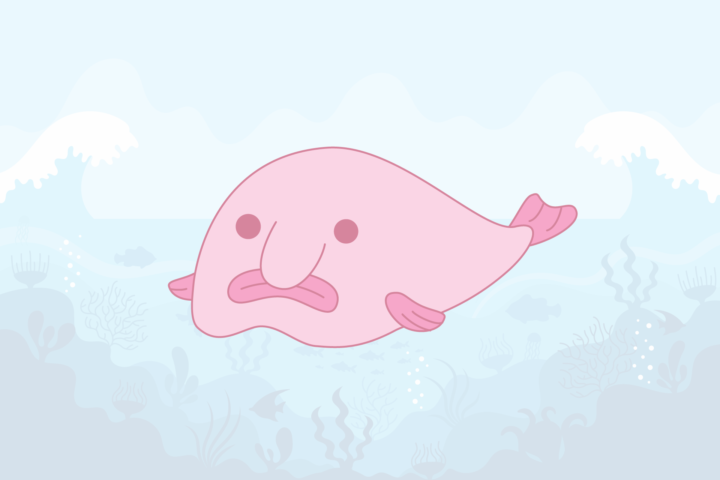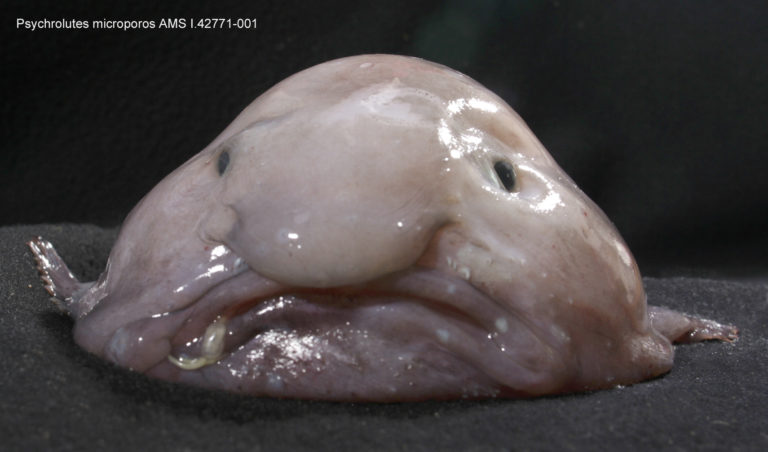The World’s “Ugliest” Animals: The Blobfish Files
By Sonia Choy 蔡蒨珩

Among the world’s ugliest animals, the blobfish will always be ranked near the top – one only needs to look at a single picture of them to understand. With their squashed flat bodies and bulging eyes, any measurement of beauty would put them into a disadvantaged position. Here are some facts about the blobfish, besides ugliness, that may surprise you.
Blobfish and Where to Find Them
Blobfish, fish in the family Psychrolutidae [1], lives at the bottom of the Atlantic, Pacific and Indian oceans [1-3]. They live at depths of approximately 600–1200 m under water, where the pressure is about 60–120 times that of atmospheric pressure [2, 4]. At this pressure, humans will surely be crushed to death, as our lungs will be unable to expand to breathe [2]. Little to no light reaches these depths; typically, beyond 200 meters, there is not enough light for photosynthesis to occur, and no light reaches beyond 1000 meters [5]. A research expedition at these depths would be too expensive, so very little is known about the blobfish and its habitat [3, 6].
About Mr. Blobby
The current picture that we have of the blobfish (Psychrolutes microporos) is from a deep-sea trawl during a research expedition in 2003 [1]. The researchers affectionately named the fish Mr. Blobby [1], due to the (rather obvious) fact that it looks like, well, a blob.

Photo credit: Kerryn Parkinson, Australian Museum © NORFANZ Founding Parties
Despite Mr. Blobby’s fame (or infamy), we don’t even know whether Mr. Blobby is male or female, since no one is going to perform an autopsy on arguably the Internet’s most famous preserved fish specimen now [6]. Little is known about the blobfish’s biology. For example, how old can they get in general? Although another deep-sea fish, rougheye rockfish, which lives at depths of 150–450 m, can live for over 200 years! One thing we know, however, is that they are mostly a jelly-like mass with very little muscle. While most other fish have a swim bladder to maintain buoyancy, the blobfish doesn’t have one because gas-filled cavities would collapse under such an extreme pressure. The blobfish is instead a mass of mostly water and fat which offers a density slightly less than that of water, allowing it to float above the sea floor without much effort. The blobfish can be an ambush predators when it comes to hunting for snails, brittle stars, anemone and other bottom dwellers. As for reproduction, they lay eggs on rocks, thousands at a time, and expectant mothers would guard their nests together.
Despite multiple campaigns striving to “Save the Blobfish”, the truth is that we don’t even have enough data to conclude whether it is an endangered species, and how bottom trawling and ocean acidification could affect the species [2, 7]. Whether there are millions or hundreds of blobfish in the world, nevertheless, one thing we must hold onto is to care for all animals, no matter their appearance. Just like humans, we can’t judge an animal by its cover, after all.
The Psychology of Ugliness … and a Misunderstanding
You might have seen videos of ugly animals around social media, but have you ever thought about why people even share them? At first thought, it seems like humans are programmed to appreciate beauty and therefore repel ugly things, but there seems to be a sort of “ugly-cute” that humans find endearing. These “ugly-cute” animals are usually characterized by big bulging eyes, large heads, and soft-looking bodies [8]. If these sound slightly familiar, it’s because things we consider cute and lovable, such as puppies and infants, also share the above characteristics. Ethologists suggested that humans are naturally built to take care of their offspring, so seeing these features causes a rush of emotion in us which manifests as cuteness [9]. So, it is no wonder that Mr. Blobby was voted the world’s ugliest animal by the Ugly Animals Preservation Society in 2013 – it is ugly, yes, but still endearing in a certain way.
Yet, some might sill argue that Mr. Blobby is not ugly at all – in its usual habitat, it just looks like, well, a regular fish. The pressure of the deep sea helps hold the blobfish’s body together in a fish-like shape, but when it is dragged out of the water, the sudden drop of pressure causes its body to expand into a balloon, which looks very different from its usual appearance – just as humans would certainly look a bit squashed 1,200 m underwater. It is no surprise that even the photographer, Dr. Kerryn Parkinson, admitted that the famous picture of Mr. Blobby was no decent scientific image [6]. But seeing how loved Mr. Blobby is now across the world, it might not be a bad thing after all!
References:
[1] Australian Museum. (2022, April 28). Blobfish (aka Mr Blobby). https://australian.museum/learn/animals/fishes/fathead-psychrolutes-aka-mr-blobby/
[2] National Geographic. (n.d.). Blobfish. https://www.nationalgeographic.com/animals/fish/facts/blobfish
[3] Wood, C. (2021, December 8). What the Heck Is a Blobfish? Live Science. https://www.livescience.com/64817-blobfish.html
[4] Schultz, C. (2013, September 13). In Defense of the Blobfish: Why the ‘World’s Ugliest Animal’ Isn’t as Ugly as You Think It Is. Smithsonian Magazine. https://www.smithsonianmag.com/smart-news/in-defense-of-the-blobfish-why-the-worlds-ugliest-animal-isnt-as-ugly-as-you-think-it-is-6676336/
[5] The National Oceanic and Atmospheric Administration. (2023, January 20). How far does light travel in the ocean? https://oceanservice.noaa.gov/facts/light_travel.html#:~:text=The%20aphotic%20zone%20exists%20in,zone%20is%20bathed%20in%20darkness.
[6] Dalton, A. (2022, February 28). “I try to find the beauty in everything”: Checking in on the fugly fish that broke the internet. Australian Geographic. https://www.australiangeographic.com.au/topics/wildlife/2022/02/i-try-to-find-the-beauty-in-everything-checking-in-on-the-fugly-fish-that-broke-the-internet/
[7] Taylor, I. (2022, February 10). The blobfish: A bloated guide to the world’s ugliest animal (and what they really look like). BBC Science Focus. https://www.sciencefocus.com/nature/the-blobfish-a-bloated-guide-to-the-worlds-ugliest-animal/
[8] Langley, L. (2017, March 18). This Is Why We Find ‘Ugly’ Animals Cute. National Geographic. https://www.nationalgeographic.com/science/article/animals-ugly-cute-psychology
[9] Borgi, M., Cogliati-Dezza, I., Brelsford, V., Meints, K., & Cirulli, F. (2014). Baby schema in human and animal faces induces cuteness perception and gaze allocation in children. Frontiers in Psychology, 5, 411. https://doi.org/10.3389/fpsyg.2014.00411